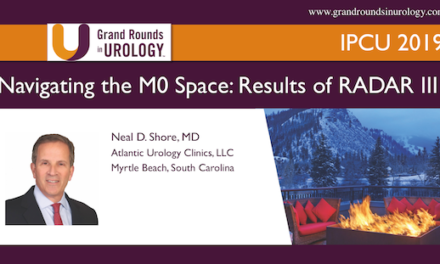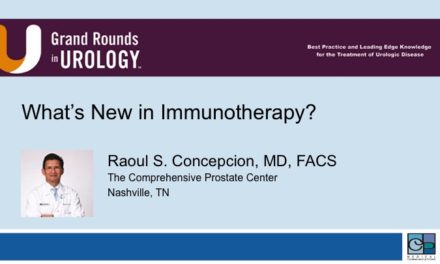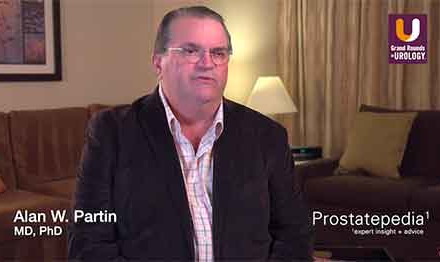Dr. Neal D. Shore spoke at the 24th International Prostate Cancer Update on Saturday, February 22, 2014 on “Update on Vaccine and Immunotherapy.” In his presentation, Dr. Shore discusses the latest updates on using immunotherapy in treating prostate cancer patients.
Presentation:
Keywords: antigen cascade, provenge, prostvac, ARM, survival benefit, t cells, immunotherapy
How to cite: Shore, Neal D. “Update on Vaccine and Immunotherapy” Grand Rounds in Urology. January 20, 2015. Accessed Nov 2024. https://dev.grandroundsinurology.com/prostate-cancer-neal-d-shore-vaccine-and-immunotherapy
Transcript
Update on Vaccine and Immunotherapy
I think the first time I gave a presentation on this was back in 2010 and it’s just skyrocketed in terms of what we know and there’s so much more to know, but it’s clearly now a foundation in terms of our therapy, not just in prostate cancer, but in other solid tumors as well. But let me just try to give you an update.
Everyone should be familiar with the logistics behind obtaining Provenge in the clinic through three cycles as a course and the pheresis process. The Impact trial, which led to the approval of Provenge was culminated with a paper in the New England Journal in 2010. It was a two to one randomization and ultimately the Kaplan-Meier curve showed a 4.1-month survival benefit.
The thing that everybody should know by now is how well it’s tolerated, how unique the mechanism of action is, and how essentially for the most part, it allows for sequencing and ongoing trials of looking at combinatorial studies, especially with the novel oral agents such as abiraterone and enzalutamide.
But one of the things that happened when we saw the approval of Provenge and other immunotherapeutics is we didn’t see much modulation in PSA, we didn’t see much impact on objective disease progression. So what were some other markers that we could look at? So there’s a little bit of a lag with the science catching up with the clinical overall survival benefit. So that’s what I’m going to show you today rather than get into the granularity of the trials and all the data, which is clearly in the public domain.
But looking at the Impact trial, one could see if you look over here at the control and the –- cell T arm CD54, which is clusterin differentiation 54, which is another correlate for what’s called “intracytoplasmic adhesion molecule,” which really is a lot of long-winded words for saying a surrogate for antigen-presenting cell up-regulation. And if you up regulate the APCs, something’s going on that’s further modifying improving T cell recognition of antigens and in this case for Provenge, it’s a prostatic acid phosphatase.
So you can pretty clearly see that in the fusion protein PA 2024 is really the prime patent issues and the importance of Provenge, which up regulates T cells. And if you just simply focus on the PA 2024 and look at the control arm versus the — cell T arm, one can see the differential in what’s called a “stimulation index,” which is another way of looking for T cell up-regulation.
So I showed you the last slide was on T cell up-regulation. This is looking at antibody titers and this is really nice work by Nadeem Sheikh, that’s been presented at AACR. And again really demonstrating as you saw on the previous slide, the T cell up-regulation, but also an improvement in antibody titers, and this is typically noted by IgG correlation.
There were some other studies that were done early on that didn’t include CRPC population and one of them was a neoadjuvant study looking at patients with localized prostate cancer, and you can see the schema here. They received Provenge and then went on to get radical prostatectomy.
I’m going to show you some of the data from that study and this was presented by — and now I believe it’s pending in press. But if you look at the interface in this histopathology, you can actually see through IFC staining that the patients who received the Provenge, we see these up-regulation of T cell markers. You see the lists there.
Interestingly, the ones with the CD are helper and killer cell primarily. The FOX P3 is more of a regulatory impact on reducing T regulatory suppressor cells. CD20 is a B cell marker. The key here is the parameters are showing in staining the interface between malignant tissue and immunotherapeutic response.
T cell infiltration was further seen as they presented as well looking at these same markers in comparison to benign tissue in those who were treated versus those who weren’t. And so there’s histopathologically something going on. There is activity rather than just as some have said in the past, “We give the therapy and we just have to take comfort in knowing that these patients are going to live longer.” But indeed the science is clearly catching up with the clinical trial data. And it’s not just T cells, but it’s also B cell antibody effect as well.
Now, one of the key things about immunotherapy which makes it more interesting and exciting compared to cytotoxic chemotherapies or ongoing oral hormonal therapies, is those therapies only work as long as you’re giving them. They don’t have memory like most of our vaccine therapies.
What you see here are some earlier studies that were done through utilizing Provenge in P10, P11 studies, and time’s not going to allow me to go into those exact trials. But look at the X axis and see how far out those patients have been followed now. These were not your typical CRPC patients. These were more androgen-sensitive populations.
Look and one can see the long-term memory of these immune responses and that’s ultimately the Holy Grail of immunotherapy, is to give a therapy so that it has continued long-term activation. And that’s what these gamma interferon ELISPOT assays are showing you here. Long-term memory effect to the fusion protein PA 2024.
Now I think David has presented this earlier and Paul Shellhammer has written this and published this in urology. This is quite compelling and if one really focuses on these core tile data, granted it was post hoc. It was retrospective.
But you see across the line, looking at the different core tiles of the baseline entry for the Impact Provenge trial, that everybody benefitted, but particularly, the patients with lower PSAs, which would certainly correlate with lower tumor burden. Lower tumor burden, less immunosuppression. And if one looks at that hazard ratio 0.51, it is statistically significant. And this is just a — plot again looking at the benefit of treating patients with lower PSAs.
So antigen cascade. This is just a spoiler alert, an ARS question at the end. What is antigen cascade? So antigen cascade has been very nicely described by many others. In addition to the concept of long-term memory, wouldn’t it be nice if we attacked one protein, one antigen. It gets attacked by our T cells in our immune system and then allows for the permeation of other antigens which then can be recognized by the immune system. So there’s this cascading effect bolstering the immunologic effect.
One sees that over here in this diagram and sort of going from left to right, basically the T cell sees the antigen on the tumor. The antigen presenting cells incorporates. It could be any one of these antigens that gets – 1, PAP, PSMA. The list goes on and on. And these then get released and now the naiveté cell picks up one of these other antigens that had not been previously identified in the vaccine. So the concept is that this goes on and keeps recurring and you get this cascading or antigenic spread.
So what’s the evidence for this? This was all theoretical and now we’re starting to build evidence that this clearly does exist and one can see, and I’ll show you some nice work that was just presented at GU ASCO in a minute by Chuck Drake, that further shows that in addition to PAP, other antigens have been detected as well with immunologic assays.
I apologize for the small print here, but ultimately, I’ll let you read through it a little bit, but in that particular last file, was looking at other antigens such as KLK2, HK2, KRAS, a very ubiquitous antigen in CRPS. But the conclusion that Chuck had at this GU ASCO was that in looking back at the Impact trial data, we see humeral antigen spread associated with improved overall survival. So like I said, this paper was published in 2010. We’re sort of catching up now with the science.
But what are some of the unresolved issues. Adoption has clearly been slower than expected. It’s only approved in the United States right now. The EMA has approved it. I correct that and I think it’s now going to be started accessibility throughout Europe, but for now, it’s been mostly in the U.S. Primarily within the community, some academic centers are championing it as well.
There’s no documented delay in time to progression. So there have been some challenges in incorporating this into a treatment discussion I think with patients in the lack of a marker benefit as it doesn’t really modulate PSA. And further appropriate timing, when and how, I think most would agree that it’s an earlier disease, lower tumor burden, patients less immunosuppressed.
So Prostvac vaccine formulation TRICOM. Fascinating also T cell potentiator looking at different cassettes, such as a vaccinia virus and then fowlpox virus to allow for subcutaneous administration does not require a leukopheresis. So one of the things that’s particularly easy about this is its accessibility in the clinic or what some have described as “off the shelf.” You see at the bottom what constitutes the TRICOM formulation.
In the initial inoculum, it’s using the vaccinia virus, which is a very large pocket to allow for these three molecules, really combined for stimulation of T cells. And one can look through this and see the similar concept of activating APCs and ultimately going to T lymphocyte recognition.
Like most immunotherapeutics, it’s all predicated on a prime boost strategy and if one looks at some of the work that’s been done at Bavarian Nordic, which is championing the Prostvac platform and looking at gamma interferon, as well as other assays, tumor necrosis factor, IL2. By giving that boost phenomenon, that second, third, fourth inoculum, one sees additional immune system recognition and stimulation of antibody response.
In earlier studies, and a lot of this work has come from Jim Gulley, one sees PSA specific T cell responses as well, clearly demonstrating immunologic recognition in the Prostvac treatment arm versus the control arm. And similarly, this concept of antigenic spread, which has a real sex appeal to it because one, it’s targeting PSA. But then other important targeted antigens can then come into play by building or cascading or spreading this immuno phenomenon. There’s a long list of really nice early work that’s been done and published.
So the Prostvac phase two trial was very compelling and interesting in that it led to an 8.5 month overall survival benefit. So the basis of this 8.5 month median overall survival benefit in phase two has led now to the PROSPECT ongoing trial, which is looking at this Prostvac vaccine therapy with GMCSF as an adjuvant versus not versus a placebo control arm. And so patients will get Prostvac in a two to one randomization divided by receiving GMCSF or not, which is also an immune adjuvant.
Just moving along for purposes of time, ipilimumab, a CTLA4 antibody inhibitor. So we see with Prostvac and Provenge ways to stimulate T cell. When you get ipilimumab and PD1, PD ligand 1, we’re looking at checkpoint inhibitors where we take the brake off T cell stimulation. So this demonstrates where ipi blocks its CTLA 4 site and there’s also been some suggestion too that it also can decrease T regulatory suppressor effects as well.
Now this study was just recently presented by Chuck Drake at GU ASCO in San Francisco. It’s a failed trial in that they didn’t show statistical significance in this post chemotherapy population. Patients received a single dose of radiation sort of to stimulate antigenic exposure. Some would describe this as try to go for what’s known as an “abscopal effect” or to stimulate further immune recognition.
What’s interesting I think has been talked about at this symposium is the challenge we have in looking at overall survival data, especially as we get further cross-contamination from approved therapies which have a de minimis effect on both arms. Because we have so many other approved therapies that become available that patients cross over to that impacts survival.
So ultimately, the study did not show statistical significance in this post chemotherapeutic arm of getting ipi versus not. Now ipilimumab, also known as Yervoy, is already approved in metastatic melanoma and clearly having an effect in that solid tumor disease state. So there’s been a lot of interest in looking at it both in post and pre-chemotherapeutic trials, and this is the post chemotherapy that’s now been rolled out.
If one looks at, this is a busy slide, but this _– plot, one can see that there are subgroups that did much better than others. And again, post hoc analysis in the subgroups as you would probably imagine, it did better. Lower tumor burden, patients without visceral metastases. Patients with visceral metastases were allowed into this trial. So patients without visceral metastases, hemoglobins greater than 11, and lower alkaline phosphatase, two parameters consistent with lower tumor burden, clearly did better. Clearly, the group with visceral metastases did not.
So when one looks at the OS, the presence of visceral metastasis and you break it out into two lines, particularly looking at the blue line at the very top, ipi no visceral metastasis versus the placebo, one sees a rather compelling overall survival delta of greater than four months. So one of the challenges we have with our studies is looking at the stratification and further looking at what accessibility there is depending upon where in the world the trials are being conducted. This again speaks to the post hoc analysis, looking at hemoglobin levels, as well as no visceral metastases.
Chuck’s conclusion, and he made a really good point of saying that it didn’t meet its endpoint. It came very close. Did not meet it. It was not statistically significant, but sub analysis were. And I think clearly that therapeutics like ipi and PD1, PD ligand 1, which are checkpoint inhibitors in conjunction with T cell activators, are clearly ripe for further investigation.
So the thing about immunotherapeutics, which I said earlier, was lower tumor burden, finding and identifying these patients earlier on, the benefit of potential long-term memory, the potential certainly for antigenic spread. Mathematical models have been looked at. There are nice publications by Ravi Modi and others, Schulum and Gulley, where we try to understand why we’re not seeing impact on progression-free survival. But in effect, what we’re really probably seeing is a static effect on progression and basically going from somewhat of a cidal to a static concept.
If you don’t give therapy, patients succumb and ultimately when you give an immunotherapeutic, you develop a more static effect in terms of progression. Somewhat of a different concept from when we give cidal toxicities or cidal therapeutics.
I think combination therapies, the green line on the bottom, is extremely important. We’re going to see more of these combinatorial studies. They’re ongoing now. We’ve had multiple ones with the new oral approved therapies. We have a paucity of really high-quality studies with radiation therapy and those are developing as well, and further development of combinatorial strategies with androgen deprivation therapy or not. Androgen deprivation therapy is known to stimulate further T cell production in the thymus, but there are other therapies that are looking at potentially utilizing immunotherapeutics in the non-castrate setting.
So I’ll take my ARS question. Antigenic cascade describes mounting adverse side effects of autoimmunity, diffuse and nonspecific hangover syndrome in the cascade bar, augmenting immune response to other antigens, T and B cell proliferation within the control group. There might be two correct answers. So everybody got that right and two is kind of correct as well.
One more ARS question please? Immunotherapeutics with CRPC have approved combinatorial indications with novel oral hormonal agents, require specific certification for administration, have a mechanism of action which is clearcut, may be considered as foundational therapy for lower tumor burden, less immunocompromised patients are still experimental.
References
Aragon-Ching JB, Williams KM, Gulley JL. Impact of androgen-deprivation therapy on the immune system: implications for combination therapy of prostate cancer. Front Biosci. 2007 Sep 1;12:4957-71. http://www.ncbi.nlm.nih.gov/pubmed/17569623
Drake CG, Doody AD, Mihalyo MA, et al. Androgen ablation mitigates tolerance to a prostate/prostate cancer-restricted antigen. Cancer Cell. 2005 Mar;7(3):239-49. http://www.ncbi.nlm.nih.gov/pubmed/15766662
Drake CG. Prostate cancer as a model for tumour immunotherapy. Nat Rev Immunol. 2010 Aug;10(8):580-93. http://www.ncbi.nlm.nih.gov/pubmed/20651745
Drake CG, Sharma P, Gerritsen W. Metastatic castration-resistant prostate cancer: new therapies, novel combination strategies and implications for immunotherapy. Oncogene. 2014 Oct 23;33(43):5053-64. http://www.ncbi.nlm.nih.gov/pubmed/24276248
Fong L, Small EJ. Anti-cytotoxic T-lymphocyte antigen-4 antibody: the first in an emerging class of immunomodulatory antibodies for cancer treatment. J Clin Oncol. 2008 Nov 10;26(32):5275-83. http://www.ncbi.nlm.nih.gov/pubmed/18838703
Gulley JL, Drake CG. Immunotherapy for prostate cancer: recent advances, lessons learned, and areas for further research. Clin Cancer Res. 2011 Jun 15;17(12):3884-91. http://www.ncbi.nlm.nih.gov/pubmed/21680544
Gulley JL. Therapeutic vaccines: the ultimate personalized therapy? Hum Vaccin Immunother. 2013 Jan;9(1):219-21. http://www.ncbi.nlm.nih.gov/pubmed/22995839
Kantoff PW, Higano CS, Shore ND, et al. Sipuleucel-T immunotherapy for castration-resistant prostate cancer. N Engl J Med. 2010 Jul 29;363(5):411-22. http://www.ncbi.nlm.nih.gov/pubmed/20818862
Kirkwood JM, Butterfield LH, Tarhini AA, et al. Immunotherapy of cancer in 2012. CA Cancer J Clin. 2012 Sep-Oct;62(5):309-35. http://www.ncbi.nlm.nih.gov/pubmed/22576456
Madan RA, Gulley JL, Fojo T, et al. Therapeutic cancer vaccines in prostate cancer: the paradox of improved survival without changes in time to progression. Oncologist. 2010;15(9):969-75. http://www.ncbi.nlm.nih.gov/pubmed/20798195
Mercader M, Bodner BK, Moser MT, et al.T cell infiltration of the prostate induced by androgen withdrawal in patients with prostate cancer. Proc Natl Acad Sci U S A. 2001 Dec 4;98(25):14565-70. http://www.ncbi.nlm.nih.gov/pubmed/11734652
Nesslinger NJ, Ng A, Tsang KY, et al. A viral vaccine encoding prostate-specific antigen induces antigen spreading to a common set of self-proteins in prostate cancer patients. Clin Cancer Res. 2010 Aug 1;16(15):4046-56. http://www.ncbi.nlm.nih.gov/pubmed/20562209
Schellhammer PF, Chodak G, Whitmore JB, et al. Lower baseline prostate-specific antigen is associated with a greater overall survival benefit from sipuleucel-T in the Immunotherapy for Prostate Adenocarcinoma Treatment (IMPACT) trial. Urology. 2013 Jun;81(6):1297-302. http://www.ncbi.nlm.nih.gov/pubmed/23582482
Schlom J. Therapeutic cancer vaccines: current status and moving forward. J Natl Cancer Inst. 2012 Apr 18;104(8):599-613. http://www.ncbi.nlm.nih.gov/pubmed/22395641
Sfanos KS, Bruno TC, Meeker AK, et al. Human prostate-infiltrating CD8+ T lymphocytes are oligoclonal and PD-1+.Prostate. 2009 Nov 1;69(15):1694-703. http://www.ncbi.nlm.nih.gov/pubmed/19670224
Slamon DJ, Leyland-Jones B, Shak S, et al. Use of chemotherapy plus a monoclonal antibody against HER2 for metastatic breast cancer that overexpresses HER2. N Engl J Med. 2001 Mar 15;344(11):783-92. http://www.ncbi.nlm.nih.gov/pubmed/11248153
Vermorken JB, Mesia R, Rivera F, et al. Platinum-based chemotherapy plus cetuximab in head and neck cancer. N Engl J Med. 2008 Sep 11;359(11):1116-27. http://www.ncbi.nlm.nih.gov/pubmed/18784101
ABOUT THE AUTHOR
Neal D. Shore, MD, FACS, is the Medical Director for the Carolina Urologic Research Center. He practices with Atlantic Urology Clinics in Myrtle Beach, South Carolina.
Dr. Shore has conducted more than 350 clinical trials, focusing mainly on genitourinary oncology, and serves on the executive boards of the Society of Urologic Oncology and the Bladder Cancer Advocacy Network. He is Past President of the Large Urology Group Practice Association. He is a founder for both CUSP Clinical Trials Consortium and DASHKO, a national urology practice data registry. He serves as the National Urology Research Director for 21st Century Oncology. He has served on the AUA Male Health Committee and the AUA Data Committee, the SITC Task Force for Prostate Cancer, the Bladder Cancer Advocacy Think Tank, and the Editorial Boards of Review in Urology, Urology Times, Chemotherapy Advisor, OncLive, PLOS ONE, Urology Practice, and World Journal of Urology. He serves as Editor of Everyday Urology-Oncology. Dr. Shore has written more than 200 peer-reviewed publications and numerous book chapters. He performs peer review for Lancet Oncology, New England Journal of Medicine, European Urology, the Journal of Urology, Urology, BJUI, PCPD, and numerous other high-impact scientific journals.
A graduate of Duke University and Duke University Medical School, Dr. Shore completed a 6-month clinical research fellowship in Pretoria, South Africa, and then completed his General Surgery/Urology training at New York Hospital Cornell Medical Center and at Memorial Sloan-Kettering Cancer Center in New York City. He is a Fellow of the American College of Surgeons.





